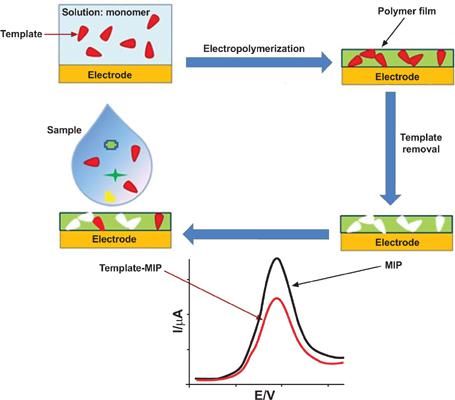Current Pharmaceutical Analysis ( IF 0.7 ) Pub Date : 2020-05-31 , DOI: 10.2174/1573412915666190304150159
Burcin Bozal-Palabiyik 1 , Cem Erkmen 1 , Bengi Uslu 1

|
Background: The molecular imprinting technique has been applied in many fields including separation, artificial antibody mimics, catalysis, sensing studies, and drug delivery. The reasons for the popularity of this technique among the researchers are high selectivity due to the cavities that are formed on the polymer surface for the specific analyte, high robustness, high durability under extreme conditions and low cost. When these advantages are combined with the advantages of electrochemical methods such as rapid response time, ease of use, cheapness and miniaturizability, Molecularly Imprinted Polymer (MIP) based electrochemical sensors turn out to be a widely-preferred sensing tool.
Objective: This article provides the reader with information on MIP-based electrochemical sensors and reviews the applications of the MIP sensors prepared by electropolymerization of orthophenylenediamine, a monomer whose mechanical and chemical stability is very high. Results and Conclusion: The literature survey summarized in this review shows that cyclic voltammetry is the most widely preferred electrochemical technique for electropolymerization of o-PD. The media chosen is generally acetate or phosphate buffers with different pH values. Although there are numerous solvents used for template removal, generally methanol and NaOH have been chosen.中文翻译:

分子印迹电化学传感器:基于邻苯二甲胺聚合的分析和制药应用
背景:分子印迹技术已应用于许多领域,包括分离,人工抗体模拟,催化,传感研究和药物递送。这项技术在研究人员中普及的原因是由于在聚合物表面形成了用于特定分析物的空腔,因此具有很高的选择性,很高的耐用性,在极端条件下的耐久性以及低成本。当将这些优点与电化学方法的优点(例如快速响应时间,易用性,便宜和微型化)相结合时,基于分子印迹聚合物(MIP)的电化学传感器被证明是一种广受欢迎的传感工具。
目的:本文为读者提供有关基于MIP的电化学传感器的信息,并回顾了通过邻苯二胺(一种机械和化学稳定性非常高的单体)的电聚合制备的MIP传感器的应用。 结果与结论:本综述总结的文献调查表明,循环伏安法是o-PD电聚合最广泛使用的电化学技术。选择的介质通常是具有不同pH值的醋酸盐或磷酸盐缓冲液。尽管有许多用于去除模板的溶剂,但通常选择了甲醇和NaOH。
































 京公网安备 11010802027423号
京公网安备 11010802027423号